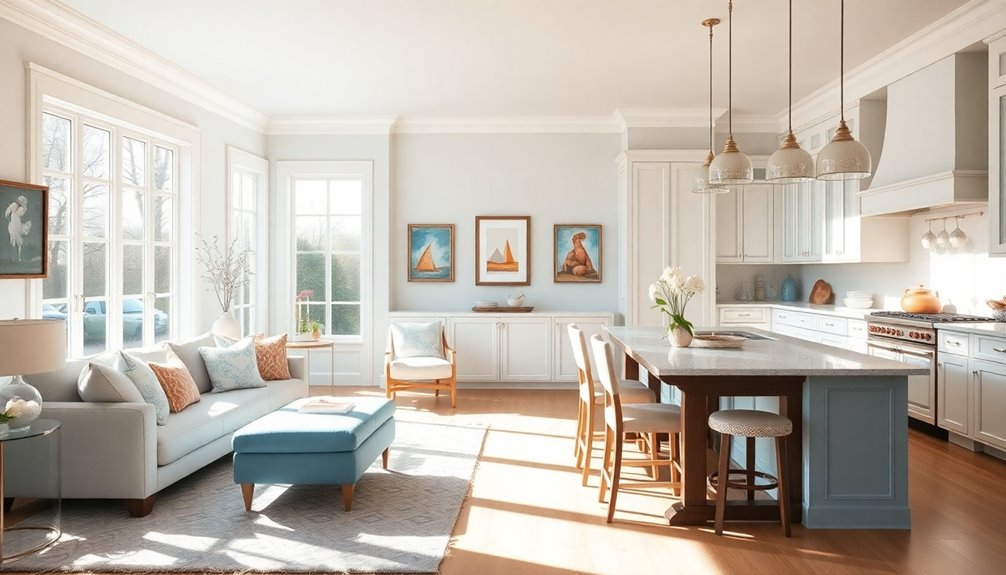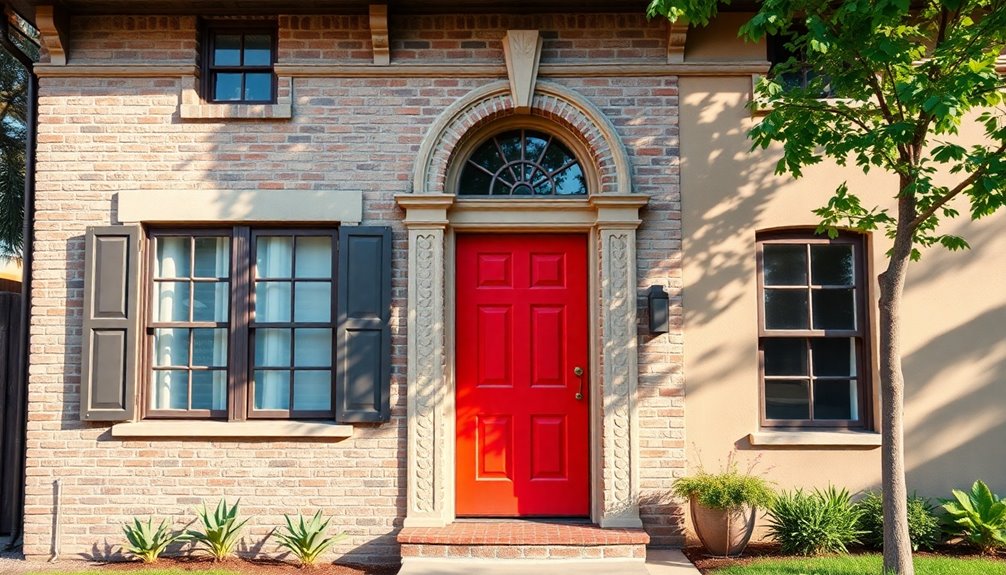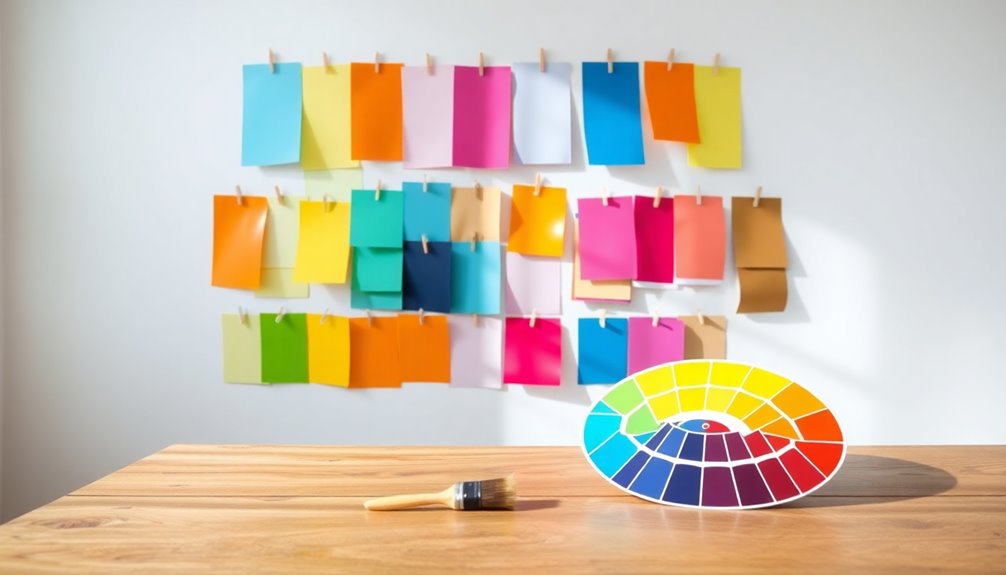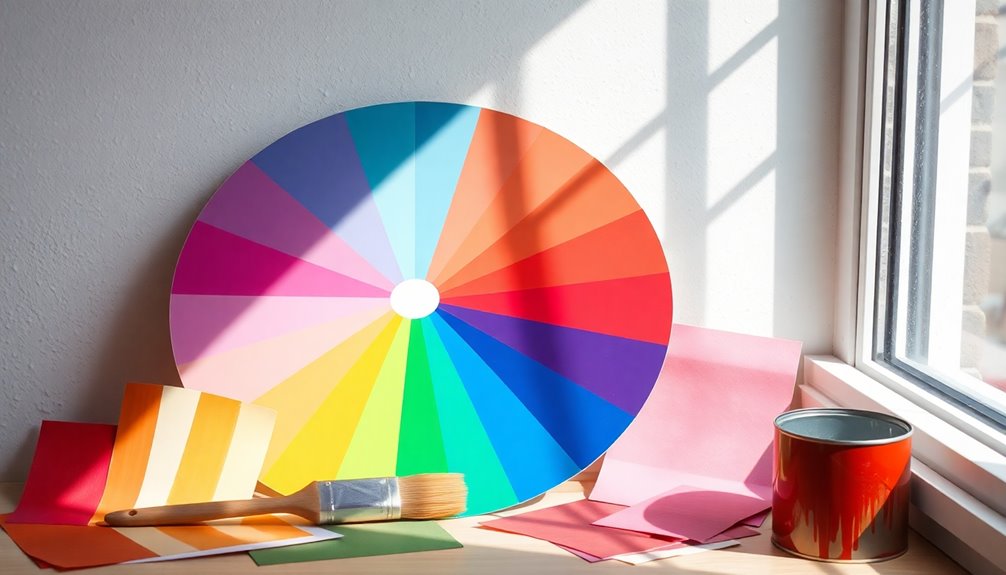When choosing paint colors, it's crucial to avoid seven common mistakes. First, consider your whole home for a cohesive look, using neutrals that adapt well. Don't rely too heavily on small swatches, as they can mislead you; instead, use larger sample boards. Always account for lighting since it drastically shifts color perception throughout the day. Choose the right finish for durability and aesthetics, and don't hesitate to consult experts who understand color theory. Lastly, always test samples in your space before making a final decision. Want to ensure you make the best choices? Keep going to find out more!
Key Takeaways
- Avoid relying solely on small swatches; opt for larger sample boards to better visualize color on walls.
- Test colors in various lighting conditions to see how they change throughout the day.
- Choose a consistent color palette throughout your home to maintain aesthetic unity and avoid clashing tones.
- Select the appropriate finish for each room, considering durability and moisture resistance in high-use areas.
- Consult professionals to avoid common pitfalls and to ensure a well-informed color selection process.
Not Considering the Whole Home

When you're choosing paint colors, it's easy to get caught up in the details of a single room.
However, overlooking the entire home can lead to a disjointed look. Aim for a consistent color palette across spaces to enhance aesthetic unity. Neutral colors like light earth tones or shades of white work best, as they adapt well to various lighting and room sizes. Timeless neutrals such as warm off-whites or muted grays ensure a cohesive look throughout your home. Be cautious of strong undertones; they can create an uncomfortable atmosphere. Utilizing data-driven insights can help you understand how color choices impact mood and perception across different spaces.
Always test colors in different rooms to see how they interact with natural light and your furniture.
Relying Too Heavily on Swatches

How often do you find yourself relying on small paint swatches to make a decision?
These tiny squares can be misleading. They don't accurately represent how the color will look on a full wall, especially when you consider different lighting and room elements. Colors can shift dramatically under various light conditions, making small swatches unreliable. Additionally, incorporating natural elements like wood and stone in your bathroom design can create a more cohesive aesthetic that complements your chosen color palette.
Plus, when you apply swatches directly on the wall, they can interfere with each other, creating uneven patches that complicate your choice. Instead, try using larger sample boards to see the true character of the color. This approach allows for better comparison and flexibility, giving you a clearer picture before committing to a shade. Additionally, allowing swatches to cure for 24 hours gives you a more accurate representation of how the color will deepen after application.
Forgetting About Lighting

Choosing the right paint color can be further complicated by overlooking the impact of lighting.
Natural light varies throughout the day, influencing how colors appear. For instance, morning light is cooler while evening light casts a warm glow. North-facing rooms tend to have softer, cooler light, making colors seem more subdued, whereas south-facing rooms enhance vibrancy. Different light sources also play a crucial role; the type and temperature can make colors look either muted or brilliant.
Test your paint samples in different areas and at various times of the day. By observing how colors shift with light, you can ensure your chosen hues truly reflect the atmosphere you want to create in your space.
Not Using the Right Finish

While it's easy to focus solely on color, neglecting the right finish can lead to disappointing results. Choosing the appropriate finish is crucial, especially in high-moisture areas like kitchens and bathrooms. For these spaces, opt for semi-gloss or high-gloss finishes, as they're durable, easy to clean, and mildew resistant. Keep in mind that while high-gloss finishes are the most durable, they can highlight imperfections. Semi-gloss offers a balance of durability and reflectivity without being too harsh. Additionally, the chosen finish can significantly affect the surface durability of paint, making it essential to select wisely. For general areas, consider satin or eggshell finishes, which can hide imperfections better. Remember, the right finish not only enhances aesthetics but also ensures longevity, so don't overlook this important detail in your painting project.
Not Consulting With Experts

Even with the right finish, overlooking the advice of experts can lead to significant painting blunders.
Without professional guidance, you might underestimate the importance of color theory and how different lights affect your choices. You may not realize how to test paint colors properly, leading to disappointing results. Regular audits of your color selection process can help identify areas for improvement and ensure consistency in your choices.
Experts help ensure you avoid poor color selections that clash with your decor or fail to match the room's purpose. They also minimize costly mistakes and streamline your decision-making process, ultimately enhancing the utilization of existing elements in your space.
By consulting with professionals, you'll gain insights into creating the desired ambiance and maximizing existing elements in your space.
Ignoring the Home's Architecture

When you ignore your home's architecture, you risk selecting paint colors that clash with or detract from the space's unique features.
Consider the room size and layout; lighter colors can open up small spaces, while darker shades create intimacy in larger rooms. Lighter colors can enhance the openness in small spaces, making them feel larger and more inviting. Additionally, incorporating energy-efficient appliances can help create a harmonious environment that complements your chosen colors.
Pay attention to architectural details like crown molding—contrasting colors can highlight these features beautifully.
Always account for natural light; south-facing rooms may need cooler tones, while north-facing ones can benefit from warmer hues.
Additionally, choose colors that reflect the room's function; calming shades work well in bedrooms, while vibrant tones enhance social spaces.
Lastly, ensure your color scheme remains cohesive to maintain balance throughout your home.
Not Testing Paint Samples

Failing to test paint samples can lead to costly mistakes and disappointment in your final color choice.
Always clean the surface and, if needed, apply a primer for an even base. Use proper tools like brushes and painter's tape to ensure accuracy.
Test colors directly on your walls or with sample boards, but remember to apply multiple coats to see the true hues. Additionally, testing ensures satisfaction with the final result while considering real-world conditions like lighting, surface texture, and room size.
Evaluate how colors look in different lighting conditions, especially near windows and in high-traffic areas.
Avoid relying solely on paint chips, as they can misrepresent the final result.
Remember to document your observations over time, and don't skip the primer, especially for vibrant colors.
Testing is essential for making informed decisions!
Frequently Asked Questions
How Do I Choose a Color for a Small Room?
To choose a color for a small room, focus on light, airy hues that enhance space.
Light colors, like soft pastels or neutrals, create an illusion of openness. Avoid dark shades, especially on ceilings, as they can shrink the room visually.
Consider how natural light interacts with your chosen color, and test large samples on your walls to see the overall effect.
A seamless color scheme will help the space feel harmonious and inviting.
What Are the Best Colors for Increasing Home Value?
Imagine your home as a canvas, where colors tell a story.
If you want to increase your home's value, consider using dark gray and earth tones. For instance, charcoal gray in the kitchen could boost your sale price by over $2,500.
Mint green adds a fresh touch, while a bold black front door might raise your offer by nearly $6,500.
Choose these colors wisely, and watch your home's appeal soar!
Can I Mix Different Paint Finishes in One Room?
Absolutely, you can mix different paint finishes in one room! Just be smart about your combinations.
Pair flat with satin or semi-gloss for a sophisticated look, and consider the room's purpose. For kitchens and bathrooms, eggshell or semi-gloss works best for easy cleaning.
Keep sheens limited to avoid a cluttered appearance and ensure they complement each other.
Test how different finishes look under your room's lighting before committing to your final choices.
How Often Should I Repaint My Home's Interior?
Wondering how often you should repaint your home's interior?
Typically, you'll want to consider a repaint every 5-10 years, depending on the room. High-traffic areas might need a refresh every 3-7 years, while moisture-exposed rooms may require more frequent touch-ups.
Regular maintenance and quality paint can extend that timeframe. Keep an eye out for signs of wear, and don't hesitate to consult a professional for tailored advice.
What Are the Best Tools for Applying Paint Evenly?
To apply paint evenly, start with a good quality paint roller for large areas; choose the right nap length for your surface.
For detailed work, grab a brush that suits your paint type.
Consider using a paint sprayer for quick coverage, but be cautious of overspray.
Don't forget multi-purpose painter's tools for added versatility.
Always ensure your tools are clean and in good condition to achieve the best results.
Conclusion
So, go ahead and ignore these mistakes if you want your home to resemble a patchwork quilt gone wrong! Who needs a cohesive look, anyway? Forget about lighting and finishes; just slap on whatever colors strike your fancy. Consulting with experts? Pfft! You've got Pinterest, right? Embrace the chaos and let your walls tell a story—preferably one of confusion and regret. After all, nothing says "welcome home" like a vibrant clash of hues that even Picasso would envy!









